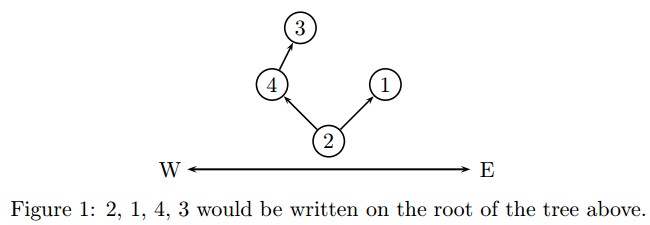Elves are very peculiar creatures. As we all know, they can live for a very long time and their magical prowess are not something to be taken lightly. Also, they live on trees. However, there is something about them you may not know. Although delivering stuffs through magical teleportation is extremely convenient (much like emails). They still sometimes prefer other more “traditional” methods.
So, as a elven postman, it is crucial to understand how to deliver the mail to the correct room of the tree. The elven tree always branches into no more than two paths upon intersection, either in the east direction or the west. It coincidentally looks awfully like a binary tree we human computer scientist know. Not only that, when numbering the rooms, they always number the room number from the east-most position to the west. For rooms in the east are usually more preferable and more expensive due to they having the privilege to see the sunrise, which matters a lot in elven culture.
Anyways, the elves usually wrote down all the rooms in a sequence at the root of the tree so that the postman may know how to deliver the mail. The sequence is written as follows, it will go straight to visit the east-most room and write down every room it encountered along the way. After the first room is reached, it will then go to the next unvisited east-most room, writing down every unvisited room on the way as well until all rooms are visited.
Your task is to determine how to reach a certain room given the sequence written on the root.
For instance, the sequence 2, 1, 4, 3 would be written on the root of the following tree.

2
4
2 1 4 3
3
1 2 3
6
6 5 4 3 2 1
1
1
E WE EEEEE
题解:精灵族住在一颗倒着的二叉树上,这棵二叉树是从东到西编号,最东边是1,依次类推,邮递员要给精灵送信,每次邮递员都在最底下的点上,让输出邮递员的路径,思想就是建一颗倒着的二叉树,如果编号小就在东边建,也就是右边,大了就建在左边,每次建图直接把路径存上就妥了;
代码:
#include<iostream>
#include<cstdio>
#include<cstring>
#include<cmath>
#include<algorithm>
#include<vector>
using namespace std;
#define mem(x,y) memset(x,y,sizeof(x))
const int MAXN=1010;
vector<char>path[MAXN];
struct Node{
Node *L,*R;
int nu;
Node(int x=0):nu(x){
L=NULL;R=NULL;
}
}*rot;
void inst(int x){
Node *p=rot;
while(1){
if(x>p->nu){
path[x].push_back(‘W‘);
if(p->L==NULL){
p->L=new Node(x);
break;
}
else p=p->L;
}
else{
path[x].push_back(‘E‘);
if(p->R==NULL){
p->R=new Node(x);
break;
}
else p=p->R;
}
}
}
int main(){
int T,n,q;
scanf("%d",&T);
while(T--){
for(int i=0;i<MAXN;i++)path[i].clear();
scanf("%d",&n);
int x;
scanf("%d",&x);
rot=new Node(x);
for(int i=1;i<n;i++){
scanf("%d",&x);
inst(x);
}
scanf("%d",&q);
while(q--){
scanf("%d",&x);
for(int i=0;i<path[x].size();i++)
printf("%c",path[x][i]);
puts("");
}
}
return 0;
}
